|
|
|
Sort Order |
|
|
|
Items / Page
|
|
|
|
|
|
|
| Srl | Item |
| 1 |
ID:
122902
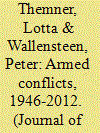

|
|
|
|
|
| Publication |
2013.
|
| Summary/Abstract |
In 2012, the Uppsala Conflict Data Program (UCDP) recorded 32 armed conflicts with a minimum of 25 battle-related deaths. This is a significant decrease from the 37 recorded in 2011. Overall, the 2000s has been the least conflict-ridden decade since the 1970s. A worrying finding, however, is that the number of internationalized intrastate conflicts continued to be at a high level for the fourth consecutive year. At six, the number of wars - conflicts leading to 1,000 or more battle-related deaths - remained the same as in 2011. In total, UCDP estimates that the conflicts that were active in 2012 caused between 37,175 (low estimate) and 60,260 (high estimate) battle-related deaths, with a best estimate of 37,941. The conflict that caused the highest number of fatalities in 2012 is the Syrian conflict, which led to between 14,830 (low) and 30,805 (high) battle-related deaths, with the best estimate being 15,055. Eleven armed conflicts listed in 2011 were not active in 2012; however, three new conflicts erupted during the year - India (Garoland), Mali and South Sudan vs. Sudan (common border) - and three previously registered conflicts were resumed by new actors. Lastly, 2012 saw an increase in the number of signed peace agreements which had been at a very low level over the past three years; four accords were concluded during the year, compared with one in 2011.
|
|
|
|
|
|
|
|
|
|
|
|
|
|
|
|
| 2 |
ID:
122897
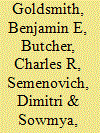

|
|
|
|
|
| Publication |
2013.
|
| Summary/Abstract |
We present what is, to the best of our knowledge, the first published set of annual out-of-sample forecasts of genocide and politicide based on a global dataset. Our goal is to produce a prototype for a real-time model capable of forecasting one year into the future. Building on the current literature, we take several important steps forward. We implement an unconditional two-stage model encompassing both instability and genocide, allowing our sample to be the available global data, rather than using conditional case selection or a case-control approach. We explore factors exhibiting considerable variance over time to improve yearly forecasting performance. And we produce annual lists of at-risk states in a format that should be of use to policymakers seeking to prevent such mass atrocities. Our out-of-sample forecasts for 1988-2003 predict 90.9% of genocide onsets correctly while also predicting 79.2% of non-onset years correctly, an improvement over a previous study using a case-control in-sample approach. We produce 16 annual forecasts based only on previous years' data, which identify six of 11 cases of genocide/politicide onset within the top 5% of at-risk countries per year. We believe this represents substantial progress towards useful real-time forecasting of such rare events. We conclude by suggesting ways to further enhance predictive performance.
|
|
|
|
|
|
|
|
|
|
|
|
|
|
|
|
| 3 |
ID:
122903
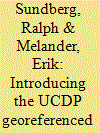

|
|
|
|
|
| Publication |
2013.
|
| Summary/Abstract |
This article presents the UCDP Georeferenced Event Dataset (UCDP GED). The UCDP GED is an event dataset that disaggregates three types of organized violence (state-based conflict, non-state conflict, and one-sided violence) both spatially and temporally. Each event - defined as an instance of organized violence with at least one fatality - comes with date, geographical location, and identifiers that allow the dataset to be linked to and merged with other UCDP datasets. The first version of the dataset covers events of fatal violence on the African continent between 1989 and 2010. This article, firstly, introduces the rationale for the new dataset, and explains the basic coding procedures as well as the quality controls. Secondly, we discuss some of the data's potential weaknesses in representing the universe of organized violence, as well as some potential biases induced by the operationalizations. Thirdly, we provide an example of how the data can be used, by illustrating the association between cities and organized violence, taking population density into account. The UCDP GED is a useful resource for conflict analyses below the state and country-year levels, and can provide us with new insights into the geographical determinants and temporal sequencing of warfare and violence.
|
|
|
|
|
|
|
|
|
|
|
|
|
|
|
|
| 4 |
ID:
122899


|
|
|
|
|
| Publication |
2013.
|
| Summary/Abstract |
As far back as Thucydides, scholars have hypothesized that power affects the onset of conflict. Despite its importance, power remains a difficult concept to measure, and scholars have primarily relied on material measures that quantify the internal resources available to a state. This concentration on internal sources of power, however, excludes an important power resource available to a state: its external relations. It is reasonable to expect that when a state estimates the power of a potential opponent it looks not only at the internal resources but also at the power of states that would likely join the conflict. In this article, we develop a new measure of external power that explicitly accounts for the external sources of state power. Unlike previous studies that aggregate a state's expected alliance contributions, our measure is based on the expected contribution of all states, allies and non-allies alike. We conduct a preliminary test of this new measure on dispute onset, and our results provide support for power preponderance over balance of power theories. External power parity contributes to dispute onset rather than deterrence. In addition, we show that examining the combined, rather than individual, effects of external and internal power produces some intriguing results, suggesting that one state's internal power preponderance can be offset by another state's preponderance of external power. These results altogether suggest that further studies examining the role of external power can produce fruitful results.
|
|
|
|
|
|
|
|
|
|
|
|
|
|
|
|
| 5 |
ID:
122900


|
|
|
|
|
| Publication |
2013.
|
| Summary/Abstract |
Past studies have applied insights from the democratic peace to show that democracies are also less likely to sanction one another compared to other regime types. More recent work challenges this finding by arguing that the economic peace between democracies largely disappears once methodological improvements are included along with the particular behavior of the United States as market hegemon. This article cautions that these critiques may themselves be an artifact of particularities in past data on economic sanctions. Using a larger and more representative sanctions dataset, the analysis shows that democracies do seem less likely on average to sanction each other. Furthermore, the United States does not appear to be unique in its sanctioning behavior compared to other democracies. However, the article proposes a middle ground between proponents and skeptics of an economic peace between democracies. The analysis shows that the pacifying effects of joint democracy only operate for security related sanctions, while in non-security related matters democratic constraints are less evident. The results point to the importance of considering more closely the choice of data on sanctions, but also the need to take into account the issues under contention for episodes of economic coercion.
|
|
|
|
|
|
|
|
|
|
|
|
|
|
|
|
| 6 |
ID:
122901
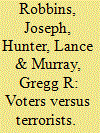

|
|
|
|
|
| Publication |
2013.
|
| Summary/Abstract |
Scholars and policymakers commonly assume terrorism is intended to affect a broader audience beyond the physically targeted victims. Informed by scholarship regarding the effects of heuristics and emotion on political cognition and behavior, we evaluate the impact of terrorism on the broader audience of the electorate as manifested by voter turnout. We hypothesize that increased terrorism is associated with increased voter turnout. In particular, we invoke the Affective Intelligence model and its related findings that emotion plays a key role in individuals' political cognition and behavior. Following this perspective, we argue that terrorist attacks are threatening and novel political events that induce anxiety in the electorate, which, in turn, leads individuals to scrutinize the political environment more closely and to ascribe greater salience to proximate political events. As a result of this increased concern with the political environment and increased salience of upcoming elections, we expect voter turnout to increase. While conventional explanations of turnout are important, they do not capture the effect of emotions despite other well-known relationships, such as attitudinal responses to international political crises (e.g. the rally-around-the-flag effect). Our cross-national analyses, which include 51 democracies and use two geographically and definitionally distinct datasets, indicate that the positive relationship between terrorism and turnout is non-trivial and robust.
|
|
|
|
|
|
|
|
|
|
|
|
|
|
|
|
| 7 |
ID:
122898
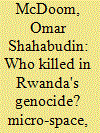

|
|
|
|
|
| Publication |
2013.
|
| Summary/Abstract |
In episodes of intergroup violence, which group members participate and which do not? Although such violence is frequently framed as occurring between distinct ethnic, racial or sectarian groups, it is easily overlooked that it is usually only a subset of the group's members who in fact participate in the violence. In predicting participation, extant research has privileged an atomistic approach and identified individual attributes indicative of a predisposition to violence. I suggest instead that a situational approach should complement the atomistic paradigm and present evidence that an individual's micro-spatial environment is an important predictor of differential participation in intergroup violence. Using GIS data on 3,426 residents from one community, I map the household locations of participants, non-participants, and victims of Rwanda's 1994 genocide. I find that participants are likely to live either in the same neighbourhood or in the same household as other participants. Specifically, as the number of violent to nonviolent individuals in an individual's neighbourhood or household increases, the likelihood of this individual's participation also increases. In explaining these neighbourhood and household effects, I suggest social influence is the mechanism at work. As micro-spatial distance decreases, micro-social interaction increases. Neighbours and household members exert influence for and against participation. Participation then may be as much the product of social interaction as of individual agency. What neighbours and family members think, say and do may influence participation in collective action such as intergroup violence. The conceptualization of neighbourhoods and households as micro-spheres of influences suggests the importance of social structure as a determinant of participation.
|
|
|
|
|
|
|
|
|
|
|
|
|
|
|
|
|
|
|
|
|